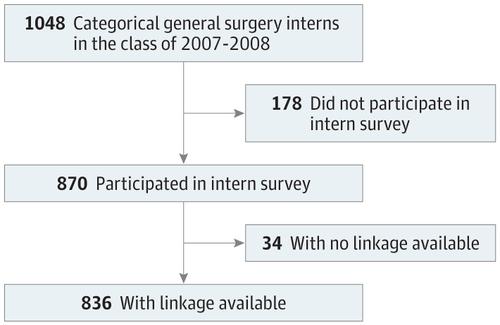JAMA Surgery ( IF 16.9 ) Pub Date : 2018-06-01 , DOI: 10.1001/jamasurg.2017.6202 Heather L. Yeo 1, 2 , Jonathan S. Abelson 1 , Matthew M. Symer 1 , Jialin Mao 2 , Fabrizio Michelassi 1 , Richard Bell 3 , Art Sedrakyan 2 , Julie A. Sosa 4, 5

|
Importance Attrition in general surgery residency remains high, and attrition that occurs in the later years is the most worrisome. Although several studies have retrospectively investigated the timing of attrition, no study to date has prospectively evaluated a national cohort of residents to understand which residents are at risk for attrition and at what point during residency.
Objective To prospectively evaluate individual resident and programmatic factors associated with the timing of attrition during general surgery residency.
Design, Setting, and Participants This longitudinal, national cohort study administered a survey to all categorical general surgery interns from the class of 2007-2008 during their first 30 days of residency and linked the data with 9-year follow-up data assessing program completion. Data were collected from June 1, 2007, through June 30, 2016.
Main Outcomes and Measures Kaplan-Meier curves evaluating time to attrition during the 9 years after the start of residency.
Results Among our sample of 836 residents (306 women [36.6%] and 528 men [63.2%]; gender unknown in 2), cumulative survival analysis demonstrated overall attrition for the cohort of 20.8% (n = 164). Attrition was highest in the first postgraduate year (67.6% [n = 111]; absolute rate, 13.3%) but continued during the next 6 years, albeit at a lower rate. Beginning in the first year, survival analysis demonstrated higher attrition among Hispanic compared with non-Hispanic residents (21.1% vs 12.4%; P = .04) and at military programs compared with academic or community programs after year 1 (32.3% vs 11.0% or 13.5%; P = .01). Beginning in year 4 of residency, higher attrition was encountered among women compared with men (23.3% vs 17.4%; P = .05); at year 5, at large compared with small programs (26.0% vs 18.4%; P = .04). Race and program location were not associated with attrition.
Conclusions and Relevance Although attrition was highest during the internship year, late attrition persists, particularly among women and among residents in large programs. These results provide a framework for timing of interventions in graduate surgical training that target residents most at risk for late attrition.
中文翻译:

外科住院期间的减员时间与个人住院医师和计划因素的关联
重要性 普通外科手术住院率中的损耗率仍然很高,而在随后几年发生的损耗率最令人担忧。尽管有几项研究回顾性研究了磨损的时间,但迄今为止,尚无一项研究可对全国居民进行前瞻性评估,以了解哪些居民有遭受磨损的风险以及在居住期间的哪一点。
目的 前瞻性评估与一般外科手术住院期间的损耗时间相关的个人住院医师和计划因素。
设计,环境和参与者 这项纵向的全国队列研究在居住的前30天内对所有2007-2008年分类的普通外科实习生进行了一项调查,并将其与评估计划完成情况的9年随访数据相关联。数据收集时间为2007年6月1日至2016年6月30日。
主要成果和衡量指标 Kaplan-Meier曲线评估了居住开始后9年内的减员时间。
结果 在我们对836名居民(306名女性[36.6%]和528名男性[63.2%];性别未知的2名)的样本中,累积生存分析表明该人群的总损耗率为20.8%(n = 164)。研究生第一年的流失率最高(67.6%[n = 111];绝对率,为13.3%),但在接下来的6年中持续下降,尽管增长率较低。从第一年开始,生存分析显示,与非西班牙裔居民相比,西班牙裔人的损耗率更高(21.1%对12.4%;P = .04);与军事或学术类项目相比,第一年后的人员流失率更高(32.3%对11.0%)或13.5%;P = 0.01)。从居住的第4年开始,女性的流失率高于男性(23.3%对17.4%;P = .05); 与小计划相比,在第5年的一般情况下(26.0%比18.4%;P = .04)。种族和计划位置与损耗无关。
结论与相关性 尽管在实习年中,流失率最高,但后期流失率仍然存在,尤其是在女性和大型项目的居民中。这些结果提供了一个针对研究生外科手术干预时间安排的框架,这些干预措施的目标人群是最易发生减员的人。



























 京公网安备 11010802027423号
京公网安备 11010802027423号